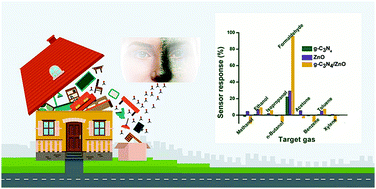A highly sensitive, selective and room temperature operatable formaldehyde gas sensor using chemiresistive g-C3N4/ZnO†
Abstract
Formaldehyde is a common indoor air pollutant whose level has to be monitored by an economic and efficient technique. Here, we report a room temperature operatable g-C3N4/ZnO-based formaldehyde gas sensor, showing higher relative sensor response (95.9%) as well as faster response/recovery time (30 s/70 s) at 50 ppm with good linearity, repeatability, selectivity and stability. Further, g-C3N4/ZnO shows that the superior performance of HCHO gas sensing compared to both pure g-C3N4 and ZnO may be due to the creation of n-n heterojunctions, which achieved the Fermi level equalization and cooperative enhancement of pure components. Thus, the optimization of structure and composition of the present g-C3N4/ZnO will offer a promising room-temperature operatable formaldehyde gas sensor in near future.



 Please wait while we load your content...
Please wait while we load your content...